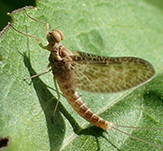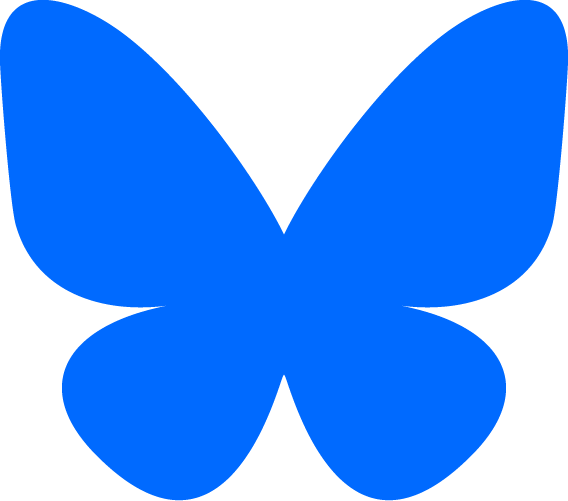Minnesota Mayflies

Order Ephemeroptera
Ephemeroptera is the order of small to medium-sized flying insects known as mayflies. They have elongated, very soft bodies. The forewings are triangular, very large, and have many veins. They are held together above the body when at rest. The hindwings are small and round, or in some species missing. The abdomen has 2 or 3 hair-like tails. The antennae are short, bristle-like, and inconspicuous. The last part of the leg (tarsus), corresponding to the foot, has 3 or 5 segments. The mouthparts are small, poorly developed, and non-functional. Adults often emerge in large numbers, sometimes piling up on the shore. Many species engage in swarming flights, where they fly up and down in unison. They do not feed and seldom live more than 1 or 2 days.
The young, called nymphs, are aquatic. They have leaf-like gills along the sides of the abdomen, and 3 hair-like tails at the end of the abdomen. Most mayfly nymphs develop in streams and rivers, some develop in lakes and ponds. The feed on small aquatic organisms and organic debris. They swim to the water surface or crawl onto emergent vegetation or rocks to complete the second-to-last molt. This subadult stage has functional wings and is called a subimago. They fly to nearby vegetation and molt one last time, emerging as adults. Mayflies are unique as the only insect that molts again after developing functional wings.
Mayflies are an important food source for freshwater fish. Fly fisherpersons use mayflies as bait.
There are more than 3,000 species in more than 400 genera in 42 families of mayflies worldwide, 611 species in 59 genera in 21 families in North America north of Mexico, and at least 75 species in 36 genera in 14 families in Minnesota. A recent review of the mayflies of Minnesota (Usher and Jacobus, 2015) compiled as list of 105 Ephemeroptera species in Minnesota. The list was compiled from collections at the University of Minnesota, historical observations in literature, and new fieldwork. Some of the rarely reported species may no longer occur in the state.
Recent Additions

Giant mayfly (Hexagenia limbata) is a large “common burrower” mayfly. It is very widespread, occurring in the United States and southern Canada from the east coast to the Great Plains and on the west coast. It is mostly absent from the desert and mountain regions in the west. It is the most common mayfly in the Midwest, and is common in Minnesota.
Larvae are found in organic, silty or mucky bottoms of lakes, ponds, and rivers, usually about three meters below the water surface. They feed on organic material suspended in the water. Immature adults are found on trees and bushes on shores near the bodies of water from which they emerged. Adults are found flying in swarms over land near the water body. They do not feed and live from just a few hours to a few days. Emergences are synchronized and can produce swarms so large that they can bee seen by weather satellites. Snow plows are sometimes used to clear dead mayflies off of roads.
Giant mayfly is said to be the largest mayfly in the United States. It can be more than one inch in length, not including two hair-like “tails” that can be equally long. The body may be yellow, yellowish-brown, brown, or even white. Aside from its very large size, giant mayfly is identified by the wing veination, and by the four-segmented end part (tarsus) of the hind leg.

Pond olive (Cloeon dipterum) is a small minnow mayfly. It occurs throughout Europe, where it is native, and in Asia and North America, where it has been introduced. The earliest North American record is from Illinois in 1953. It is now widespread across the continent. In the United States it is currently mostly restricted to the northeast and to Washington state. It is rare in Minnesota. Nymphs are found mostly in ponds, but also in the shallow margins of lakes and in slow areas of rivers and streams. They feed on algae, small aquatic organisms, and organic debris. Adults are found on vegetation near ponds. They do not feed and seldom live more than 1 or 2 days.
Adults are reddish-brown and have 2 very long hair-like tails at the end of the abdomen. The compound eyes on the female are on the sides of the head. On the male the compound eyes have additional large, orange, turban-like parts that meet at the top of the head. These adaptations are said to allow the male to isolate in a swarm females that are not yet paired with another male. Some authors say that pond olives have no hindwings. Carl Linnaeus in 1761 described the hindwings as “hardly present.”
Other Recent Additions

This list includes only mayflies that have been recorded in Minnesota, but not all of the mayflies found in Minnesota.
| Profile | Photo | Video | |||
|---|---|---|---|---|---|
Aphrodite’s flat-headed mayfly (Leucrocuta aphrodite) |
|
||||
bicolor spiny crawler mayfly (Eurylophella bicolor) |
|||||
big river small minnow mayfly (Pseudocloeon longipalpus) |
|||||
blue-winged olive (Serratella ignita) |
|||||
brown drake (Ephemera simulans) |
|||||
brown small minnow mayfly (Baetis brunneicolor) |
|||||
brown spiny crawler mayfly (Eurylophella funeralis) |
|||||
brush-legged mayfly (Isonychia velma) |
|||||
Burk’s spiny crawler mayfly (Dannella lita) |
|||||
burrowing mayflies (Family Ephemeridae) |
|||||
cloudy prong-gilled mayfly (Leptophlebia nebulosa) |
|||||
common small minnow mayfly (Baetis tricaudatus) |
|||||
common small square-gilled mayfly (Caenis latipennis) |
|||||
common spiny-headed burrowing mayfly (Pentagenia vittigera) |
|||||
confused small minnow mayfly (Acentrella turbida) |
|||||
dark cahill (Stenonema femoratum) |
|||||
dark hendrickson (Ephemerella subvaria) |
|||||
early brown spinner (Leptophlebia cupida) |
|||||
emergent mayfly (Hexagenia bilineata) |
|||||
filtering small square-gilled mayfly (Amercaenis ridens) |
|||||
fragile prong-gilled mayfly (Paraleptophlebia debilis) |
|||||
glassy flat-headed mayfly (Epeorus vitreus) |
|||||
golden drake (Anthopotamus distinctus) |
|||||
great red quill (Timpanoga Hecuba) |
|||||
Hebe’s flat-headed mayfly (Leucrocuta hebe) |
|||||
lake hex (Hexagenia atrocaudata) |
|||||
Laprairie small minnow mayfly (Labiobaetis frondalis) |
|||||
large blue-winged olive (Drunella cornuta) |
|||||
Laurentian armored mayfly (Baetisca laurentina) |
|||||
little black spiny crawler mayfly (Teloganopsis deficiens) |
|||||
little dark hendrickson (Ephemerella needhami) |
|||||
little sooty olive (Serratella serrata) |
|||||
maculated small square-gilled mayfly (Sparbarus maculatus) |
|||||
mahogany dun (Isonychia bicolor) |
|||||
Manitoba small minnow mayfly (Labiobaetis dardanus) |
|||||
march flat-headed mayfly (Maccaffertium vicarium) |
|||||
meager flat-headed mayfly (Maccaffertium exiguum) |
|||||
Minnetonka flat-headed mayfly (Stenacron minnetonka) |
|||||
modest flat-headed mayfly (Maccaffertium modestum) |
|||||
northern small square-gilled mayfly (Caenis diminuta) |
|||||
northern spiny crawler mayfly (Ephemerella aurivillii) |
|||||
northern summer mayfly (Siphlonurus alternatus) |
|||||
orange cahill (Stenacron interpunctatum) |
|||||
pale dun (Ephemerella dorothea) |
|||||
pale morning dun (Ephemerella excrucians) |
|||||
pretty flat-headed mayfly (Maccaffertium pulchellum) |
|||||
pretty small minnow mayfly (Callibaetis pretiosus) |
|||||
ringed small minnow mayfly (Acentrella parvula) |
|||||
Rock Island small minnow mayfly (Labiobaetis propinquus) |
|||||
Say’s small square-gilled mayfly (Caenis hilaris) |
|||||
simple spiny crawler mayfly (Dannella simplex) |
|||||
small mayfly (Paracloeodes minutus) |
|||||
small mayfly (Pseudocloeon propinquum) |
|||||
small minnow mayfly (Acentrella rallatoma) |
|||||
small square-gilled mayfly (Cercobrachys etowah) |
|||||
small-horned spiny crawler mayfly (Drunella cornutella) |
|||||
southern flat-headed mayfly (Maccaffertium mexicanum) |
|||||
spiny crawler mayfly (Ephemerella catawba) |
|||||
stream mayfly (Nixe kennedyi) |
|||||
sulphur dun (Ephemerella invaria) |
|||||
summer spiny crawler mayfly (Eurylophella aestiva) |
|||||
tardy small square-gilled mayfly (Caenis tardata) |
|||||
tapered spiny crawler mayfly (Attenella attenuata) |
|||||
temporal spiny crawler mayfly (Eurylophella temporalis) |
|||||
terminal flat-headed mayfly (Maccaffertium terminatum) |
|||||
tiny blue winged olive (Acerpenna pygmaea) |
|||||
Walker’s tusked sprawler (Anthopotamus verticis) |
|||||
Walsh’s hackle-gilled burrowing mayfly (Anthopotamus myops) |
|||||
white fly (Ephoron leukon) |
|||||
white fly (Ephoron leukon) |
|||||
yellow-streaked small minnow mayfly (Baetis flavistriga) |
|||||
Young’s small square-gilled mayfly (Caenis youngi) |
Acentrella parvula (ringed small minnow mayfly)
Acentrella rallatoma (small minnow mayfly)
Acentrella turbida (confused small minnow mayfly)
Acerpenna pygmaea (tiny blue winged olive)
Amercaenis ridens (filtering small square-gilled mayfly)
Anthopotamus distinctus (golden drake)
Anthopotamus myops (Walsh’s hackle-gilled burrowing mayfly)
Anthopotamus verticis (Walker’s tusked sprawler)
Attenella attenuata (tapered spiny crawler mayfly)
Baetis brunneicolor (brown small minnow mayfly)
Baetis flavistriga (yellow-streaked small minnow mayfly)
Baetis tricaudatus (common small minnow mayfly)
Baetisca laurentina (Laurentian armored mayfly)
Caenis diminuta (northern small square-gilled mayfly)
Caenis hilaris (Say’s small square-gilled mayfly)
Caenis latipennis (common small square-gilled mayfly)
Caenis tardata (tardy small square-gilled mayfly)
Caenis youngi (Young’s small square-gilled mayfly)
Callibaetis ferrugineus (red speckled dun)
Callibaetis pretiosus (pretty small minnow mayfly)
Cercobrachys etowah (small square-gilled mayfly)
Dannella lita (Burk’s spiny crawler mayfly)
Dannella simplex (simple spiny crawler mayfly)
Drunella cornuta (large blue-winged olive)
Drunella cornutella (small-horned spiny crawler mayfly)
Epeorus vitreus (glassy flat-headed mayfly)
Ephemera simulans (brown drake)
Ephemerella aurivillii (northern spiny crawler mayfly)
Ephemerella catawba (spiny crawler mayfly)
Ephemerella dorothea (pale dun)
Ephemerella excrucians (pale morning dun)
Ephemerella invaria (sulphur dun)
Ephemerella needhami (little dark hendrickson)
Ephemerella subvaria (Dark Hendrickson)
Ephemerellidae (spiny crawler mayflies)
Ephemeridae (burrowing mayflies)
Ephoron album (white fly)
Ephoron leukon (white fly)
Eurylophella aestiva (summer spiny crawler mayfly)
Eurylophella bicolor (bicolor spiny crawler mayfly)
Eurylophella funeralis (brown spiny crawler mayfly)
Eurylophella lutulenta (dirty spiny crawler mayfly)
Eurylophella temporalis (temporal spiny crawler mayfly)
Hexagenia atrocaudata (lake hex)
Hexagenia bilineata (emergent mayfly)
Hexagenia limbata (giant mayfly)
Isonychia bicolor (mahogany dun)
Isonychia velma (brush-legged mayfly)
Labiobaetis dardanus (Manitoba small minnow mayfly)
Labiobaetis frondalis (Laprairie small minnow mayfly)
Labiobaetis propinquus (Rock Island small minnow mayfly)
Leptophlebia cupida (early brown spinner)
Leptophlebia nebulosa (cloudy prong-gilled mayfly)
Leucrocuta aphrodite (Aphrodite’s flat-headed mayfly)
Leucrocuta hebe (Hebe’s flat-headed mayfly)
Maccaffertium exiguum (meager flat-headed mayfly)
Maccaffertium mexicanum (southern flat-headed mayfly)
Maccaffertium modestum (modest flat-headed mayfly)
Maccaffertium pulchellum (pretty flat-headed mayfly)
Maccaffertium terminatum (terminal flat-headed mayfly)
Maccaffertium vicarium (march flat-headed mayfly)
Nixe kennedyi (stream mayfly)
Paracloeodes minutus (small mayfly)
Paraleptophlebia debilis (fragile prong-gilled mayfly)
Pentagenia vittigera (common spiny-headed burrowing mayfly)
Pseudocloeon longipalpus (big river small minnow mayfly)
Pseudocloeon propinquum (small mayfly)
Serratella ignita (blue-winged olive)
Serratella serrata (little sooty olive)
Siphlonurus alternatus (northern summer mayfly)
Sparbarus maculatus (maculated small square-gilled mayfly)
Stenacron interpunctatum (orange cahill)
Stenacron minnetonka (Minnetonka flat-headed mayfly)
Stenonema femoratum (dark cahill)
Teloganopsis deficiens (little black spiny crawler mayfly)
Timpanoga Hecuba (great red quill)
No Species Page Yet?
If you do not see a linked page for a species in the list at left you can still upload a photo or video or report a sighting for that species. Click on one of the buttons below and type in the common name and/or scientific name of the species in your photo, video, or sighting. A new page will be created for that species featuring your contribution.
These buttons not working for you?
Simply email us at info@MinnesotaSeasons.com.







